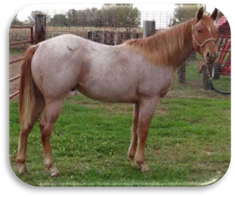HEREDITY – INCOMPLETE
DOMINANCE & CODOMINANCE

Incomplete Dominance

So far, every hereditary cross we have discussed has
been complete dominance. In complete dominance one trait is
completely dominant over another trait (recessive trait) resulting in two
phenotypes. With incomplete dominance,
there are two traits, neither of which are totally dominant, and when these
traits appear together, in a heterozygous genotype, a third phenotype appears. Incomplete dominance will involve a
third phenotype which happens to be a “mix” or “blend” of two different
phenotypes.
Incomplete Dominance Phenotype/Genotype
Example
The flower color of a plant known as a snapdragon has three different colors.
The snapdragon flower may be red, white, or pink. When an allele from the red
trait is paired with an allele from the white trait a pink-colored flower
results.
|
Snapdragon
Flower Color |
|||
|
Phenotype |
Genotype Possibilities |
||
|
Red |
RR |
RR |
RR |
|
White |
rr |
R1R1 |
WW |
|
Pink |
Rr
or rR |
RR1
or R1R |
RW
or WR |
There are a few different ways for writing the
genotypes of incomplete dominance
phenotypes, depending on the resource. Staying with our example of snapdragon flower color, some resources
will use the genotype RR to represent
Red Flowers, rr to represent White Flowers, and Rr to represent Pink Flowers.
This is probably not the best method because many students will think the White
phenotype is recessive since the genotype is two lowercase r’s. Keep in mind,
if a White Flower was truly recessive they would not influence the Red Flower
alleles when they come together to form Pink Flowers. Some resources will use RR for red, R1R1 for
white, and RR1 for pink. The R1 (said as “R prime”),
that you see in the white and pink genotypes, only uses the “1” to distinguish
one allele from another. The “1” has no other unique meaning. A third method
used for genotypes is RR for red, WW for
white, and RW for pink. Many prefer this method, however, be very careful.
The common mistake made with this method is creating a third letter for the
third phenotype. Many students will want to create a third letter of “P” for
pink. Remember, the only reason pink exists is because a red allele and a white
allele come together, there is no pink allele.
Incomplete Dominance Example
Many times you will be told when you are dealing with
an incomplete dominance cross,
however, sometimes you will not be made aware. The key is to recognize a third
phenotype. Whenever you see a third phenotype that is a mix or blend, then you
know you are involved in an incomplete
dominance cross.
For an example, we will cross the following parents:
Parents: Red snapdragon flower x White
snapdragon flower
*Little
Note: Notice how there is no need to use the terms
homozygous or heterozygous.
1.
Genotypes of Parents: RR x WW
Due to the law of segregation, the alleles will now separate
into gametes.
2.
Gametes of Parents: R, R x W, W
You will continue the process in the same fashion as
you do monohybrid crosses.
3.
Crossing the Parents’ Alleles:
|
|
R |
R |
|
W |
RW |
RW |
|
W |
RW |
RW |
4.
Genotypic Probability
Record the Genotype of the upper left box of the
Punnett square (RW). Then count how many boxes out of the 4 have that same
genotype. In this case, the genotypic
probability is 4/4 RW. The genotypic probability of this cross between the
Red Flower parent plant and White Flower parent plant tells us that 100% or all
of the offspring will be of the genotype RW.
5.
Phenotypic Probability
Record the Phenotype of the upper left box of the
Punnett square (Pink Flower). Then count how many boxes out of the 4 have that
same phenotype. In this case, the phenotypic
probability is 4/4 Pink Flower. The phenotypic probability of this cross
between the Red Flower parent plant and White Flower parent plant tells us that
100% or all of the offspring will be of the phenotype Pink Flower.
Incomplete Dominance Practice
For practice, cross the following parents:
Parents: Pink snapdragon flower x White
snapdragon flower
(Go
to the end of this unit for the answers.)
1.
Genotypes of Parents:
2.
Gametes of Parents:
3.
Crossing the Parents’ Alleles:
4.
Genotypic Probability:
5.
Phenotypic Probability:
Codominance
Codominance
occurs when both alleles for a gene are expressed in a heterozygous genotype.
In codominance, there are no
recessive alleles. Codominance
involves NO “blending” or “mixing” of alleles, as in incomplete dominance, instead, both dominant traits are expressed
in a heterozygous genotype as a third phenotype. As you already learned the
third phenotype concerning incomplete
dominance shows a “blending” of two alleles, the third phenotype concerning
codominance will have both dominant
traits expressed at the same time.
Codominance Phenotype/Genotype Example

The roan coat color of a horse demonstrates codominance. The horse’s coat color can
be red, white, or roan. The heterozygous roan coat color actually consists of
both white hairs and red hairs together, there is no mixing of color within an
individual hair. The genotypes would be RR
for red, R1R1 or WW for white, and RR1 or RW
for roan. Notice the method for creating the genotypes is the same as with incomplete dominance, but remember there
is NO blending in the heterozygous condition with codominance.
Codominance Example
For an example, we will cross the following parents:
Parents: Red coat color x White coat
color
*Little
Note: Notice how there is no need to use the terms
homozygous or heterozygous.
1.
Genotypes of Parents: RR x WW
Due
to the law of segregation, the alleles will now separate into gametes.
2.
Gametes of Parents: R, R x W, W
You
will continue the process in the same fashion as you do monohybrid crosses.
3.
Crossing the Parents’ Alleles:
|
|
R |
R |
|
W |
RW |
RW |
|
W |
RW |
RW |
4.
Genotypic Probability
Record the Genotype of the upper left box of the
Punnett square (RW). Then count how many boxes out of the 4 have that same
genotype. In this case, the genotypic
probability is 4/4 RW. The genotypic probability of this cross between the
Red Coat color and White Coat color tells us that 100% or all of the offspring
will be of the genotype RW.
5.
Phenotypic Probability
Record the Phenotype of the upper left box of the
Punnett square (Roan color). Then count how many boxes out of the 4 have that
same phenotype. In this case, the phenotypic
probability is 4/4 Roan color. The phenotypic probability of this cross
between the Red Coat color and White Coat color tells us that 100% or all of
the offspring will be of the phenotype Roan Coat.
Codominance Practice
For practice, cross the following parents:
Parents: Red Coat Color x Roan Coat
Color
(Go
to the end of this unit for the answers.)
1.
Genotypes of Parents:
2.
Gametes of Parents:
3.
Crossing the Parents’ Alleles:
4.
Genotypic Probability:
5.
Phenotypic Probability:
Answer to Incomplete Dominance Practice
1.
Genotypes of Parents: RW x WW
2.
Gametes of Parents: R, W x W, W
3.
Crossing the Parents’ Alleles:
|
|
R |
W |
|
W |
RW |
WW |
|
W |
RW |
WW |
4.
Genotypic Probability
2/4,
1/2, or 50% RW; 2/4, 1/2, or 50% WW
5.
Phenotypic Probability
2/4,
1/2, or 50% Pink Flower; 2/4, 1/2, or 50% White Flower
Answer to Codominance
Practice
1.
Genotypes of Parents: RR x RW
2.
Gametes of Parents: R, R x R, W
3.
Crossing the Parents’ Alleles:
|
|
R |
R |
|
R |
RR |
RR |
|
W |
RW |
RW |
4.
Genotypic Probability
2/4,
1/2, or 50% RR; 2/4, 1/2, or 50% RW
5.
Phenotypic Probability
2/4,
1/2, or 50% Red Coat; 2/4, 1/2, or 50% Roan Coat
Unit 24 Worksheet Heredity-Incomplete Dominance and
Codominance
UNIT VOCABULARY
REVIEW